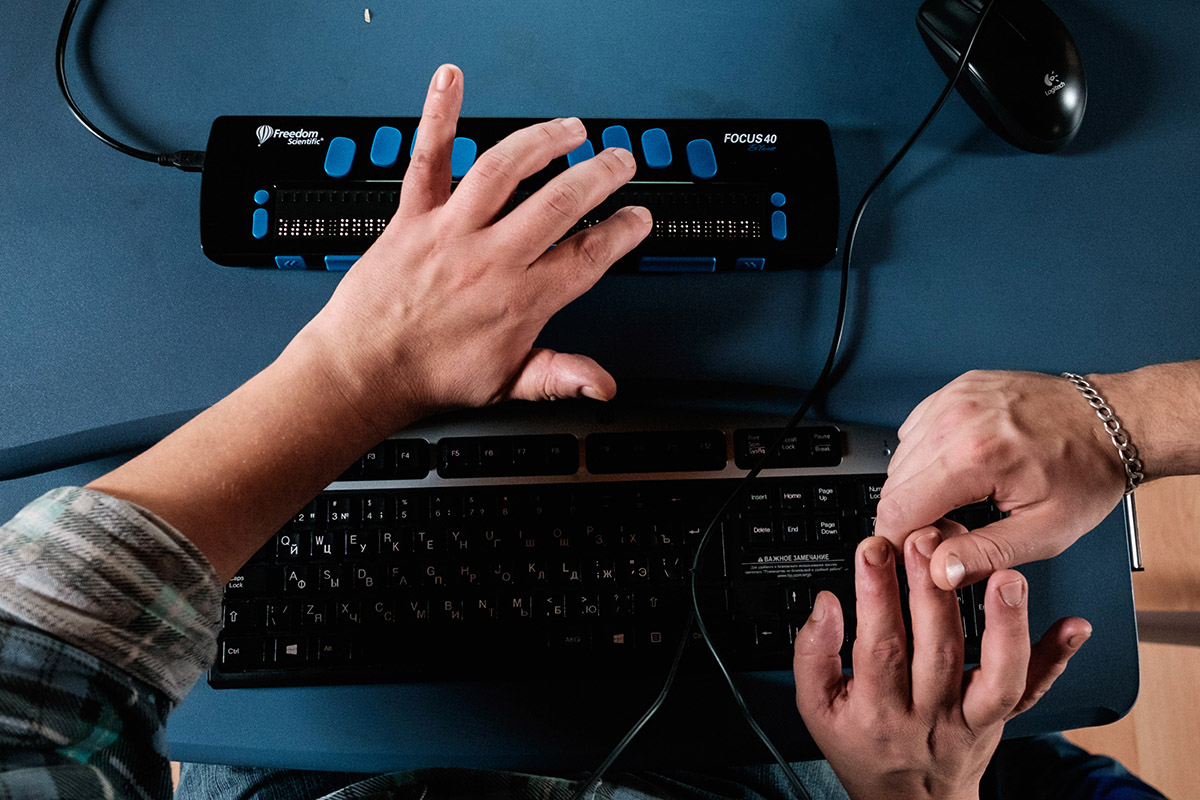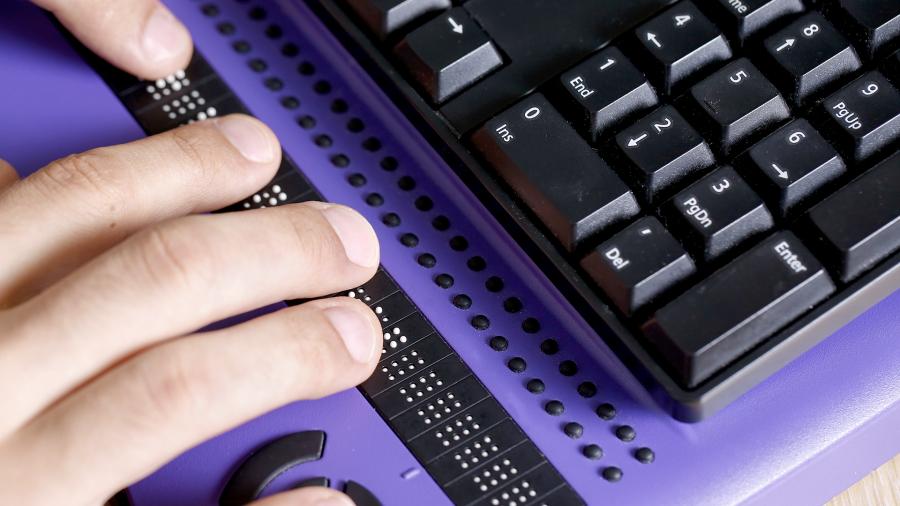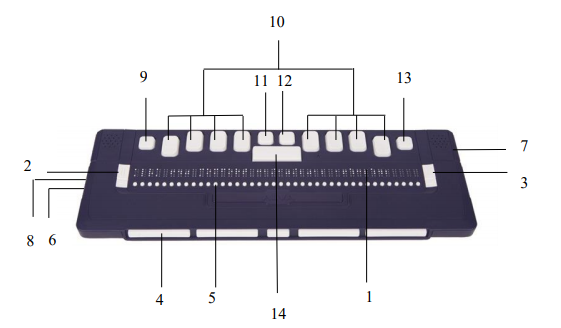
Braille display is a key means of rehabilitation for blind and deaf-blind people. Dozens of companies around the world produce it in various variations with a very different number of cells, integration with electronic devices and other features of work. Anyone who has been actively using a Braille display for a long time recommends choosing it carefully and carefully.
In the February issue of Tiflostream, four leading Russian experts in typhlotechnics, who have been using Braille displays for work and life for many years, met on the air. The one and a half hour program was entirely devoted to these devices. Who needs a braille display and why? How not to make a mistake when buying it? Which device should you choose and how to use it?
The guests of the program answered these questions:
- , , - « «».
- , , , , .
- , « », .
Oleg Shevkun was traditionally the host of Tiflostrim.
The guests of the program said that braille displays appeared back in the 90s of the XX century, but they became widespread only now.
“My first fleeting acquaintance with the Braille display happened in the Smolensk Library for the Blind. I immediately liked the ability to interact with the computer by touch. Before that meeting, I used the voice screen reader - that is, I could only work on the computer with my voice. And then they showed me a twenty-cell device, huge and heavy. But you could work with him. I tested it for 10 minutes and was very impressed. And then I found out how much it costs and forgot about Braille displays for many years, ”admitted Sergei Flaytin.
“I learned the first braille display also in the 90s, in completely dead times. But I was able to work with him only in 2000 in Paris, where some kind of typhloconference was held. Like Sergey, I heard the price and resigned myself to the fact that for many years I would not be able to afford this. Although the dream of working with a computer by touch has always remained with me ”, - supported his colleague Andrey Polikanin.
The price of the device is a stumbling block in modern realities. Although braille displays have long been mass-produced, and their cost has dropped significantly, not everyone can afford such a means of rehabilitation. Therefore, it is very important to choose exactly the device you need. And before that, understand - what exactly is it for and is it needed at all?

“In Israel, I have encountered many times situations where people buy a Braille display and put it on the shelf. The fact is that they are sold there at gigantic discounts. And people who have just mastered Braille, but do not use it in everyday life or use it very rarely - read the name of the medicine on the package - for them displays are just the interior of furniture. Their reading speed is very low and they simply cannot use the device as intended, ”said Pavel Kaplan.
According to the expert, the main thing is not the opportunity to get a device, but the motivation to master Braille. Indeed, without it, the presence of a display will not change a person's life.
Sergei Fleitin, for the most part, agrees with his colleague. According to him, blind people are no different from sighted people. Among them, for example, there are those who do not read books. They have enough TV, YouTube to kill time. The same is true among the blind. Someone is developing, and someone does not want to do anything. Therefore, there are probably many people who do not need a Braille display.
“But I look at the problem from a slightly different angle. I not only work for a company that sells braille displays, but also do community work - helping a special category of disabled people - deaf-blind people. And they really need such a device. Many of them began to learn Braille while still sighted, realizing that they would soon lose their sight (this happens with Usher's syndrome). At first, primers were used for the blind, but then the process stopped, because they still did not know how to read Braille well, there is no interline font, and the sensitivity of the fingers is low. And when such people get their hands on a Braille display, just one line makes a breakthrough in their training, ”shares his experience Sergei Flaytin.
But Andrey Polikanin is more categorical. According to the expert, in practice, in the conditions of the CIS countries, Braille displays are needed only for those who work with texts - translators, programmers, announcers, journalists and others who read and type texts. If a person does not know Braille well, for example, due to the fact that he became blind in adulthood, then for him the purchase of a device is a risk of throwing money away.
Pavel Kaplan, in turn, emphasizes that the braille display cannot be considered as an independent means of rehabilitation. It's more like a monitor for a sighted person. The display, like a speech synthesizer, is only used in conjunction with a screen reader. And much more depends on a person's ability to use this program, as well as in general, on his computer literacy.

Another issue, which has long become an acute problem of the market, is the choice of a braille display, or, according to Oleg Shevkun, its complete absence. As a rule, a blind person buys what is offered to him, and does not choose a specific model of a specific manufacturer.
Andrei Polikanin admitted that he had already burned out on this once. He received his first display for free, falling under a charity giveaway. But then the screen reader changed and it turned out that the device was not adapted to it. The Expert has already purchased the next display at his own expense.
“A Braille display is an expensive rehabilitation tool that is purchased for many years to come. My first display, when the board flew, was only 7 years old and this one was very small - I was out of luck. All experts will confirm that the display should last much longer. Their service life is 20-30 years. I know the story of a device that is 35 years old, its iron points have already become dull, but it continues to work and faithfully serve its owner, ”says Pavel Kaplan.
According to the expert, the most versatile display option is 20 or 24 cells. This is convenient to use when working at a computer and when interacting with a mobile device. It is small, compact, fits into any bag. If a person needs a display for stationary work at a computer, then Pavel Kaplan recommends 24, 32 or 40-cell devices. They are more expensive, but they will be very convenient with them.
“And I think that any braille display is better than none at all. It all depends on the financial capabilities of the person. In my environment, most people now use mobile devices and many are happy with the capabilities of the 14-cell display. It is as compact as possible, it can be used in almost any situation. However, there are people who only recognize the 40-cell device and use it even with their iPhone. These are all very subjective things. Personally, I always adapt to the situation. At home I work with pleasure on the 40-cell. But on trips I take a small display. On the road, for me, the ability to read Braille outweighs its disadvantages. I easily put up with the 14-cell display and often read very large texts with it, ”says Sergey Fleitin.
On the other hand, the expert admits that without experience using a braille display, there is a high risk of choosing a device that will seem very uncomfortable to a person.
Sergei Fleitin believes that manufacturers should provide for the possibility of a test drive for braille displays so that everyone can choose exactly what they need.
The situation is especially acute now in the regions where people come and ask for "some kind of" display, focusing mainly on the price. The result is not what they want at all.
The former secretary general of the European Union for the Deafblind advises to approach the choice of a Braille display seriously and carefully. If necessary, then come to Moscow or your regional center for it, and not buy "what is."
“We need a format for in-depth acquaintance with devices. On the basis of libraries and rehabilitation centers, it is possible to carry out "test drives" of braille displays, offering different options from different manufacturers, "sums up Sergei Fleitin.
The main problem with all technical equipment is that it does not have an intuitive interface. It simply does not exist in nature. Therefore, to learn how to use any device for the blind, you have to learn. The braille display is no exception. Future owners need to be trained in advance, and existing ones should be able to quickly exchange experience. This is very important, because the inability to acquire certain knowledge and skills can negate all the benefits of buying a Braille display.

Layout of the ALVA 640 Comfort
ALVA 640 Comfort , , (Thumb keys) .
ALVA 640 Comfort :
- 40
- (eTouch-) ( )
- (eTouch key) ( )
- (thumb keys) , , ,
- 40
- Mini USB
- ./.
- Socket for connectors
- Ctrl key
- Braille keyboard with 8 keys (key numbers from left to right are 7, 3, 2, 1, 4, 5, 6, 8)
- Windows key (to display the Windows Start menu)
- Enter key
- Alt key
- Space bar
As for specific screen access programs, here the opinions of experts were divided. JAWS is easier to get used to. NVDA is harder to work with because the braille table is worse. But if a person only needs Russian, then NVDA is quite convenient. Therefore, the program should be selected individually for personal needs.
The same goes for operating systems on mobile devices. On Android, there is only one input tool. That is, you cannot connect both a braille display and a keyboard to it at the same time.
“They often tell me:“ So we bought a display and there is a Samsung phone - how to connect them? ”. This is fundamentally the wrong approach. Still, the Braille display should come first. Even the cheapest device is much more expensive than any smartphone. Therefore, having chosen a braille display, you should already specially select a gadget or computer for it, with which you will interact using Braille, ”emphasizes Sergei Flaytin.
According to the expert, Android, due to corrupted tables and a number of other reasons, is poorly suited to work with Braille. Apple is doing much better. The official website of the company contains a lot of materials, including in Russian, dedicated to interaction with braille displays. Moreover, both general commands for all displays and the features of each specific model that Apple supports are taken into account.
The main recommendations for the operation of braille displays are simple: do not touch the keys with dirty, sweaty hands, do not get dirty, do not wet, store the device in a special case.
When choosing a device, it is important to consider not only ease of use and the number of cells, but also maintainability. When purchasing a display, it is important to know how much warranty and post-warranty service is available in your country and in your city. Otherwise, there is a risk of large additional costs.
It must be remembered that the purchase of a Braille display is a very important step in the life of every visually impaired person, which largely determines his future destiny.
To follow the latest news about innovative technologies, subscribe to our Vkontakte and Facebook pages .
The full broadcast dedicated to braille displays can be viewed on the program's YouTube channel: